- Table of Contents
- Related Documents
-
| Title | Size | Download |
|---|---|---|
| 08-IPv6 PIM configuration | 791.32 KB |
IPv6 administrative scoping overview
Relationship among IPv6 PIM protocols
IPv6 PIM-DM configuration task list
Enabling the state refresh feature
Configuring state refresh parameters
Configuring IPv6 PIM-DM graft retry timer
IPv6 PIM-SM configuration task list
Configuring IPv6 multicast source registration
Configuring common IPv6 PIM features
Configuring an IPv6 multicast data filter
Configuring a hello message filter
Configuring IPv6 PIM hello message options
Configuring common IPv6 PIM timers
Setting the maximum size of each join or prune message
Displaying and maintaining IPv6 PIM
IPv6 PIM configuration examples
IPv6 PIM-DM configuration example
IPv6 PIM-SM non-scoped zone configuration example
IPv6 PIM-SM admin-scoped zone configuration example
A multicast distribution tree cannot be correctly built
IPv6 multicast data is abnormally terminated on an intermediate router
An RP cannot join an SPT in IPv6 PIM-SM
An RPT cannot be built or IPv6 multicast source registration fails in IPv6 PIM-SM
PIM overview
Protocol Independent Multicast for IPv6 (IPv6 PIM) provides IPv6 multicast forwarding by leveraging IPv6 unicast static routes or IPv6 unicast routing tables generated by any IPv6 unicast routing protocol, such as RIPng, OSPFv3, IPv6 IS-IS, or IPv6 BGP. IPv6 PIM is not dependent on any particular IPv6 unicast routing protocol, and it uses the underlying IPv6 unicast routing to generate a routing table with routes.
IPv6 PIM uses the RPF mechanism to implement multicast forwarding. When an IPv6 multicast packet arrives on an interface of the device, the packet undergoes an RPF check. If the RPF check succeeds, the device creates an IPv6 multicast routing entry and forwards the packet. If the RPF check fails, the device discards the packet. For more information about RPF, see "Configuring IPv6 multicast routing and forwarding."
Based on the implementation mechanism, IPv6 PIM falls into the following categories:
· Protocol Independent Multicast–Dense Mode for IPv6 (IPv6 PIM-DM)
· Protocol Independent Multicast–Sparse Mode for IPv6 (IPv6 PIM-SM)
· Bidirectional Protocol Independent Multicast for IPv6 (IPv6 BIDIR-PIM)
· Protocol Independent Multicast Source-Specific Multicast for IPv6 (IPv6 PIM-SSM)
Currently, the switch does not support IPv6 PIM-DM, IPv6 BIDIR-PIM, and IPv6 PIM-SSM.
In this document, an IPv6 PIM domain refers to a network composed of IPv6 PIM routers.
IPv6 PIM-DM overview
IPv6 PIM-DM uses the push mode for multicast forwarding and is suitable for small networks with densely distributed IPv6 multicast members.
The following describes the basic implementation of IPv6 PIM-DM:
· IPv6 PIM-DM assumes that all downstream nodes want to receive IPv6 multicast data when a source starts sending, so IPv6 multicast data is flooded to all downstream nodes on the network.
· Branches without downstream receivers are pruned from the forwarding trees, leaving only those branches that contain receivers.
· The pruned state of a branch has a finite holdtime timer. When the timer expires, IPv6 multicast data is again forwarded to the pruned branch. This flood-and-prune cycle takes place periodically to maintain the forwarding branches.
· To reduce join latency when a new receiver on a previously pruned branch joins an IPv6 multicast group, IPv6 PIM-DM uses a graft mechanism to turn the pruned branch into a forwarding branch.
In IPv6 PIM-DM, the multicast forwarding paths for an IPv6 multicast group constitute a source tree, which is rooted at the IPv6 multicast source and has multicast group members as its "leaves." Because the source tree consists of the shortest paths from the IPv6 multicast source to the receivers, it is also called a "shortest path tree (SPT)."
The operating mechanism of IPv6 PIM-DM is summarized as follows:
· Graft
· Assert
Neighbor discovery
In an IPv6 PIM domain, each interface that runs IPv6 PIM on a router periodically multicasts IPv6 PIM hello messages to all other IPv6 PIM routers on the local subnet to discover IPv6 PIM neighbors, maintain IPv6 PIM neighboring relationship with other routers, and build and maintain SPTs.
SPT building
The process of building an SPT is the flood-and-prune process:
1. In an IPv6 PIM-DM domain, when the IPv6 multicast source S sends IPv6 multicast data to the IPv6 multicast group G, the IPv6 multicast data is flooded throughout the domain. A router performs an RPF check for the IPv6 multicast data. If the check succeeds, the router creates an (S, G) entry and forwards the data to all downstream nodes in the network. In the flooding process, all the routers in the IPv6 PIM-DM domain create the (S, G) entry.
2. The nodes without downstream receivers are pruned. A router that has no downstream receivers sends a prune message to the upstream node to remove the interface that receives the prune message from the (S, G) entry. In this way, the upstream stream node stops forwarding subsequent packets addressed to that IPv6 multicast group down to this node.
|
|
NOTE: An (S, G) entry contains an IPv6 multicast source address S, an IPv6 multicast group address G, an outgoing interface list, and an incoming interface. |
A prune process is initiated by a leaf router. As shown in Figure 1, the router interface that does not have any downstream receivers initiates a prune process by sending a prune message toward the IPv6 multicast source. This prune process goes on until only necessary branches are left in the IPv6 PIM-DM domain, and these necessary branches constitute an SPT.
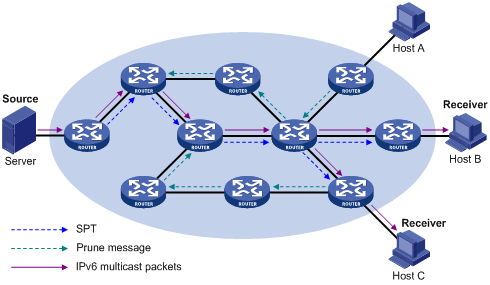
The pruned state of a branch has a finite holdtime timer. When the timer expires, IPv6 multicast data is again forwarded to the pruned branch. The flood-and-prune cycle takes place periodically to maintain the forwarding branches.
Graft
To reduce the join latency when a new receiver on a previously pruned branch joins an IPv6 multicast group, IPv6 PIM-DM uses a graft mechanism to turn the pruned branch into a forwarding branch, as follows:
1. The node that needs to receive the IPv6 multicast data sends a graft message to its upstream node, telling it to rejoin the SPT.
2. After receiving this graft message, the upstream node adds the interface that received the graft message into the outgoing interface list of the (S, G) entry for the IPv6 multicast group, and then sends a graft-ack message to the graft sender.
3. If the node that sent a graft message does not receive a graft-ack message from its upstream node, it continues to send graft messages at a configurable interval until it receives an acknowledgment from its upstream node.
Assert
On a subnet with more than one multicast router, the assert mechanism shuts off duplicate multicast flows to the network. It does this by electing a unique multicast forwarder for the subnet.
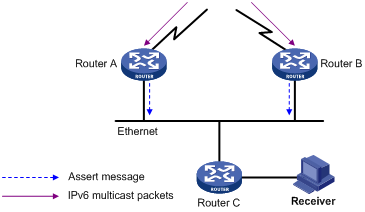
As shown in Figure 2, after Router A and Router B receive an (S, G) packet from the upstream node, they both forward the packet to the local subnet. As a result, the downstream node Router C receives two identical multicast packets, and both Router A and Router B, on their own downstream interfaces, receive a duplicate packet forwarded by the other. After detecting this condition, both routers send an assert message to all IPv6 PIM routers on the local subnet through the interface that received the packet. The assert message contains the IPv6 multicast source address (S), the IPv6 multicast group address (G), and the preference and metric of the IPv6 unicast route/MBGP route/static multicast route to the IPv6 multicast source. By comparing these parameters, either Router A or Router B becomes the unique forwarder of the subsequent (S, G) packets on the subnet. The comparison process is as follows:
1. The router with a higher preference to the IPv6 multicast source wins.
2. If both routers have the same preference to the IPv6 multicast source, the router with a smaller metric to the IPv6 multicast source wins.
3. If a tie exists in route metric to the IPv6 multicast source, the router with a higher IPv6 link-local address on the downstream interface wins.
IPv6 PIM-SM overview
IPv6 PIM-DM uses the flood-and-prune cycles to build SPTs for IPv6 multicast data forwarding. Although an SPT has the shortest paths from the IPv6 multicast source to the receivers, it is built with a low efficiency and is not suitable for large- and medium-sized networks.
IPv6 PIM-SM uses the pull mode for IPv6 multicast forwarding, and it is suitable for large-sized and medium-sized networks with sparsely and widely distributed IPv6 multicast group members.
The basic implementation of IPv6 PIM-SM is as follows:
· IPv6 PIM-SM assumes that no hosts need IPv6 multicast data. In the IPv6 PIM-SM mode, a host must express its interest in the IPv6 multicast data for an IPv6 multicast group before the data is forwarded to it. IPv6 PIM-SM implements multicast forwarding by building and maintaining rendezvous point trees (RPTs). An RPT is rooted at a router that has been configured as the rendezvous point (RP) for an IPv6 multicast group, and the IPv6 multicast data to the group is forwarded by the RP to the receivers along the RPT.
· When a receiver expresses its interest in the IPv6 multicast data addressed to a specific IPv6 multicast group, the receiver-side designated router (DR) sends a join message to the RP for the IPv6 multicast group. The path along which the message goes hop by hop to the RP forms a branch of the RPT.
· When an IPv6 multicast source sends IPv6 multicast data to an IPv6 multicast group, the source-side DR must register the IPv6 multicast source with the RP by unicasting register messages to the RP. The IPv6 multicast source stops sending register message until it receives a register-stop message from the RP. When the RP receives the register message, it triggers the establishment of an SPT. Then, the IPv6 multicast source sends subsequent IPv6 multicast packets along the SPT to the RP. After reaching the RP, the multicast packet is duplicated and delivered to the receivers along the RPT.
Multicast data is replicated wherever the RPT branches, and this process automatically repeats until the IPv6 multicast data reaches the receivers.
The operating mechanism of IPv6 PIM-SM is summarized as follows:
· IPv6 multicast source registration
· Assert
Neighbor discovery
IPv6 PIM-SM uses a similar neighbor discovery mechanism as IPv6 PIM-DM does. For more information, see "Neighbor discovery."
DR election
On a shared-media LAN like Ethernet, only a DR forwards IPv6 multicast data. A DR is required in both the source-side network and receiver-side network. A source-side DR acts on behalf of the IPv6 multicast source to sends register messages to the RP, and the receiver-side DR acts on behalf of the receiver hosts to sends join messages to the RP.
|
|
IMPORTANT: MLD must be enabled on the device that acts as the receiver-side DR. Otherwise, the receiver hosts attached to the DR cannot join any IPv6 multicast groups. For more information about MLD, see "Configuring MLD." |
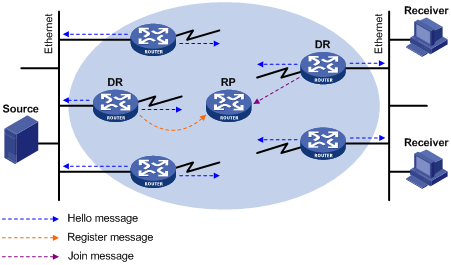
As shown in Figure 3, the DR election process is as follows:
1. The routers on the shared-media LAN send hello messages to one another. The hello messages contain the priority for DR election. The router with the highest DR priority is elected as the DR.
2. In the case of a tie in the priority, or if any router in the network does not support carrying the DR-election priority in hello messages, the router with the highest IPv6 link-local address wins the DR election.
If the DR fails, its IPv6 PIM neighbor lifetime expires, and the other routers initiate a new DR election.
RP discovery
An RP is the core of an IPv6 PIM-SM domain. For a small-sized, simple network, one RP is enough for multicast forwarding throughout the network. In this case, you can specify a static RP on each router in the IPv6 PIM-SM domain. However, in an IPv6 PIM-SM network that covers a wide area, a huge amount of IPv6 multicast data is forwarded by the RP. To lessen the RP burden and optimize the topological structure of the RPT, you can configure multiple candidate-RPs (C-RPs) in an IPv6 PIM-SM domain and use the bootstrap mechanism to dynamically elect RPs. An elected RP serves a different IPv6 multicast group. For this purpose, you must configure a bootstrap router (BSR). A BSR serves as the administrative core of an IPv6 PIM-SM domain. An IPv6 PIM-SM domain has only one BSR, but can have multiple candidate-BSRs (C-BSRs) so that, if the BSR fails, a new BSR can be automatically elected from the C-BSRs and avoid service interruption.
|
|
NOTE: · An RP can serve multiple IPv6 multicast groups, but an IPv6 multicast group has only one RP to serve the group. · A device can act as a C-RP and a C-BSR at the same time. |
As shown in Figure 4, each C-RP periodically unicasts its advertisement messages (C-RP-Adv messages) to the BSR. An advertisement message contains the address of the advertising C-RP and the IPv6 multicast group range that it serves. The BSR collects these advertisement messages and organizes the C-RP information into an RP-set, which is a database of mappings between IPv6 multicast groups and RPs. The BSR encapsulates the RP-set information in the bootstrap messages (BSMs) and floods the BSMs to the entire IPv6 PIM-SM domain.
Figure 4 Information exchange between C-RPs and BSR
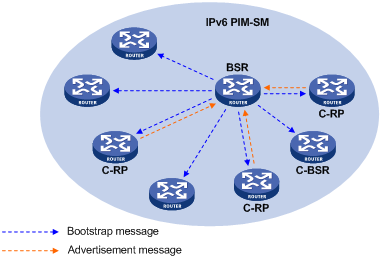
Based on the information in the RP-set, all routers in the network can select the proper RP for a specific IPv6 multicast group based on the following rules:
1. The C-RP with the highest priority wins.
2. If all the C-RPs have the same priority, the C-RP with the largest hash value (calculated through the hash algorithm) wins.
3. If all the C-RPs have the same priority and hash value, the C-RP with the highest IPv6 address wins.
Embedded RP
The embedded RP mechanism enables a router to resolve the RP address from an IPv6 multicast group address to map the IPv6 multicast group to an RP. This RP can take the place of the configured static RP or the RP dynamically elected by the bootstrap mechanism. A DR does not need to learn the RP address beforehand. The specific process is as follows:
· At the receiver side:
a. A receiver host initiates an MLD report to express its interest in an IPv6 multicast group.
b. After receiving the MLD report, the receiver-side DR resolves the RP address embedded in the IPv6 multicast group address and sends a join message to the RP.
· At the IPv6 multicast source side:
a. The IPv6 multicast source sends IPv6 multicast traffic to an IPv6 multicast group.
b. The source-side DR resolves the RP address embedded in the IPv6 multicast address, and sends a register message to the RP.
RPT building
Figure 5 RPT building in an IPv6 PIM-SM domain
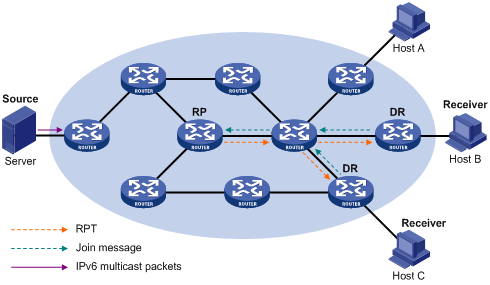
As shown in Figure 5, the process of building an RPT is as follows:
1. When a receiver wants to join the IPv6 multicast group G, it uses an MLD message to inform the receiver-side DR.
2. After getting the receiver information, the DR sends a join message, which is forwarded hop by hop to the RP that serves the IPv6 multicast group.
3. The routers along the path from the DR to the RP form an RPT branch. Each router on this branch adds to its forwarding table a (*, G) entry, where the asterisk (*) means any IPv6 multicast source. The RPT is rooted at the RP and has the DR as its leaf.
When the IPv6 multicast data addressed to the IPv6 multicast group G reaches the RP, the RP forwards the data to the DR along the established RPT, and finally to the receiver.
When a receiver is no longer interested in the IPv6 multicast data addressed to the IPv6 multicast group G, the receiver-side DR sends a prune message, which goes hop by hop along the RPT to the RP. After receiving the prune message, the upstream node deletes the interface that connects to this downstream node from the outgoing interface list and checks whether it has receivers for that IPv6 multicast group. If not, the router continues to forward the prune message to its upstream router.
IPv6 multicast source registration
The IPv6 multicast source uses the registration process to inform an RP of its presence.
Figure 6 IPv6 multicast source registration
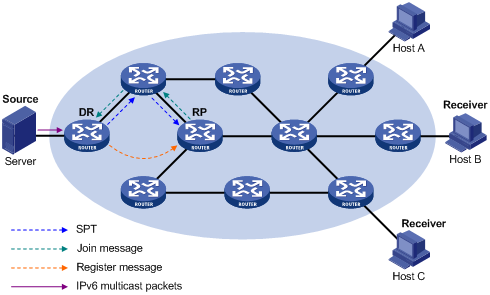
As shown in Figure 6, the IPv6 multicast source registers with the RP as follows:
1. The IPv6 multicast source S sends the first multicast packet to the IPv6 multicast group G. When receiving the multicast packet, the source-side DR that directly connects to the IPv6 multicast source encapsulates the packet in an register message and unicasts the message to the RP.
2. After the RP receives the register message, it decapsulates it and forwards it down to the RPT. Meanwhile, it sends an (S, G) source-specific join message hop by hop toward the IPv6 multicast source. The routers along the path from the RP to the IPv6 multicast source constitute an SPT branch, and each router on this branch creates an (S, G) entry in its forwarding table. The SPT is rooted at the source-side DR, and has the RP as its leaf.
3. The subsequent IPv6 multicast data from the IPv6 multicast source are forwarded to the RP along the established branch, and the RP forwards the data to the receivers along the RPT. When the IPv6 multicast data reaches the RP along the SPT, the RP unicasts a register-stop message to the source-side DR to prevent the DR from unnecessarily encapsulating the data.
Switchover to SPT
|
|
CAUTION: If the switch is an RP, disabling switchover to SPT might cause multicast traffic forwarding failures on the source-side DR. When disabling switchover to SPT, be sure you fully understand its impact on your network. |
In an IPv6 PIM-SM domain, only one RP and one RPT serve a specific IPv6 multicast group. Before the switchover to SPT occurs, the source-side DR encapsulates all IPv6 multicast data addressed to the IPv6 multicast group in register messages and sends them to the RP. After receiving these register messages, the RP decapsulates them and forwards them to the receivers-side DR along the RPT.
Switchover to STP includes the following issues:
· The source-side DR and the RP might perform complicated encapsulation and decapsulation operations.
· IPv6 multicast packets are delivered along a path that might not be the shortest one.
· An increase in IPv6 multicast traffic adds a great burden on the RP, increasing the risk of failure.
To solve these issues, IPv6 PIM-SM allows an RP or the receiver-side DR to initiate a switchover to SPT.
· The RP initiates a switchover to SPT:
When the RP receives the first IPv6 multicast packet, it sends an (S, G) source-specific join message hop by hop toward the IPv6 multicast source. The routers along the path from the RP to the IPv6 multicast source constitute an SPT branch. The subsequent IPv6 multicast data for the IPv6 multicast group can be forwarded to the RP along the branch without being encapsulated in register messages.
For more information about the switchover to SPT initiated by the RP, see "IPv6 multicast source registration."
· The receiver-side DR initiates a switchover to SPT:
When the receiver-side DR receives the first IPv6 multicast packet, it initiates a switchover to SPT as follows:
a. The receiver-side DR sends an (S, G) source-specific join message hop by hop toward the IPv6 multicast source. The routers along the path from the RP to the source-side DR create an (S, G) entry in their forwarding table to constitute an SPT branch.
b. When the multicast packets for the IPv6 multicast group are forwarded to the router where the RPT and the SPT branches, the router drops the multicast packets that reach it along the RPT and sends a prune message with the RP bit hop by hop to the RP. After receiving the prune message, the RP forwards it toward the IPv6 multicast source (supposed only one receiver exists). Thus, the switchover to SPT is completed.
c. Finally, the IPv6 multicast source sends the multicast packets for the IPv6 multicast group to the receiver along the SPT.
With the switchover to SPT, IPv6 PIM-SM builds SPTs more economically than IPv6 PIM-DM does.
Assert
IPv6 PIM-SM uses a similar assert mechanism as IPv6 PIM-DM does. For more information, see "Assert."
IPv6 BIDIR-PIM overview
In some many-to-many applications, such as a multi-side video conference, multiple receivers might be interested in the IPv6 multicast data from multiple IPv6 multicast sources. With IPv6 PIM-DM or IPv6 PIM-SM, each router along the SPT must create an (S, G) entry for each IPv6 multicast source, consuming a lot of system resources.
IPv6 BIDIR-PIM addresses the problem. Derived from IPv6 PIM-SM, IPv6 BIDIR-PIM builds and maintains a bidirectional RPT, which is rooted at the RP and connects the IPv6 multicast sources and the receivers. Along the bidirectional RPT, the IPv6 multicast sources send IPv6 multicast data to the RP, and the RP forwards the data to the receivers. Each router along the bidirectional RPT needs to maintain only one (*, G) entry, saving system resources.
IPv6 BIDIR-PIM is suitable for a network with dense IPv6 multicast sources and receivers.
The operating mechanism of IPv6 BIDIR-PIM is summarized as follows:
Neighbor discovery
IPv6 BIDIR-PIM uses the same neighbor discovery mechanism as IPv6 PIM-SM does. For more information, see "Neighbor discovery."
RP discovery
IPv6 BIDIR-PIM uses the same RP discovery mechanism as IPv6 PIM-SM does. For more information, see "RP discovery." In IPv6 BIDIR-PIM, an RPF interface is the interface toward an RP, and an RPF neighbor is the address of the next hop to the RP.
In IPv6 PIM-SM, an RP must be specified with a real IPv6 address. In IPv6 BIDIR-PIM, an RP can be specified with a virtual IPv6 address, which is called the "rendezvous point address (RPA)." The link corresponding to the RPA's subnet is called the "rendezvous point link (RPL)." All interfaces connected to the RPL can act as the RPs, and they back up one another.
DF election
On a subnet with multiple multicast routers, the same multicast packets might be forwarded to the RP repeatedly. To address this issue, IPv6 BIDIR-PIM uses a designated forwarder (DF) election mechanism to elect a unique DF for each RP on each subnet in the IPv6 BIDIR-PIM domain, and allows only the DF to forward IPv6 multicast data to the RP.
DF election is not necessary for an RPL.
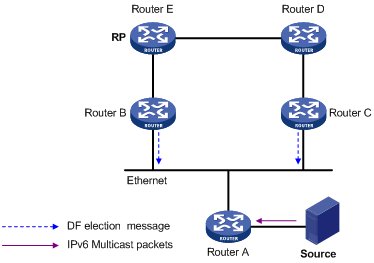
As shown in Figure 7, without the DF election mechanism, both Router B and Router C can receive IPv6 multicast packets from Route A, and both can forward the packets to downstream routers on the local subnet. As a result, the RP (Router E) receives duplicate IPv6 multicast packets. With the DF election mechanism, once receiving the RP information, Router B and Router C initiate a DF election process for the RP:
1. Router B and Router C multicast a DF election message to all IPv6 PIM routers. The election message carries the RP's address, and the priority and metric of the unicast route, MBGP route, or static multicast route to the RP.
2. The router with a route of the highest priority becomes the DF.
3. In the case of a tie in the priority, the router with the route with the lowest metric wins the DF election.
4. In the case of a tie in the metric, the router with the highest link-local IPv6 address wins.
Bidirectional RPT building
Figure 8 RPT building at the receiver side
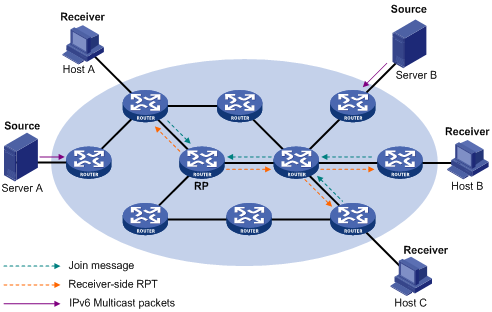
As shown in Figure 8, the process for building a receiver-side RPT is similar to that for building an RPT in IPv6 PIM-SM:
1. When a receiver wants to join the IPv6 multicast group G, it uses an MLD message to inform the directly connected router.
2. After receiving the message, the router sends a join message, which is forwarded hop by hop to the RP for the IPv6 multicast group.
3. The routers along the path from the receiver's directly connected router to the RP form an RPT branch, and each router on this branch adds to its forwarding table a (*, G) entry, where the asterisk (*) means any IPv6 multicast source.
When a receiver wants to leave the IPv6 multicast group G, the directly connected router sends a prune message, which goes hop by hop along the reverse direction of the RPT to the RP. After receiving the prune message, an upstream node removes the interface that connects to the downstream node from the outgoing interface list and checks whether it has receivers for that IPv6 multicast group. If not, the router continues to forward the prune message to its upstream router.
Figure 9 RPT building at the IPv6 multicast source side
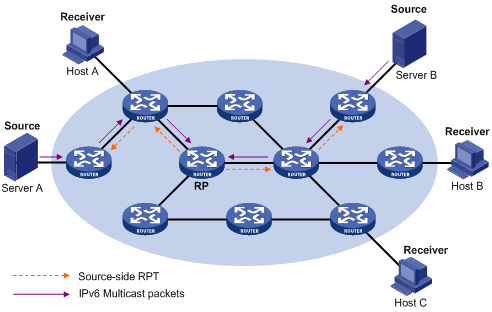
As shown in Figure 9, the process for building a source-side RPT is relatively simple:
1. When an IPv6 multicast source sends multicast packets to the IPv6 multicast group G, the DF in each subnet unconditionally forwards the packets to the RP.
2. The routers along the path from the source's directly connected router to the RP constitute an RPT branch. Each router on this branch adds to its forwarding table a (*, G) entry, where the asterisk (*) means any IPv6 multicast source.
After a bidirectional RPT is built, the IPv6 multicast sources send multicast traffic to the RP along the source-side RPT, and the RP forwards the traffic to the receivers along the receiver-side RPT.
|
|
IMPORTANT: If a receiver and an IPv6 multicast source are at the same side of the RP, the source-side RPT and the receiver-side RPT might meet at a node before reaching the RP. In this case, the multicast packets from the IPv6 multicast source to the receiver are directly forwarded by the node, instead of by the RP. |
IPv6 administrative scoping overview
Typically, an IPv6 PIM-SM domain or an IPv6 BIDIR-PIM domain contains only one BSR, which is responsible for advertising RP-set information within the entire IPv6 PIM-SM domain or IPv6 BIDIR-PIM domain. The information about all IPv6 multicast groups is forwarded within the network that the BSR administers. This is called the "IPv6 non-scoped BSR mechanism."
To implement refined management, you can divide an IPv6 PIM-SM domain or IPv6 BIDIR-PIM domain into an IPv6 global-scoped zone and multiple IPv6 administratively-scoped zones (admin-scoped zones). This is called the "IPv6 administrative scoping mechanism."
IPv6 administrative scoping mechanism
The administrative scoping mechanism effectively releases stress on the management in a single-BSR domain and enables provision of zone-specific services through private group addresses.
An IPv6 admin-scoped zone serves particular IPv6 multicast groups with the same scope field value in their group addresses. Zone border routers (ZBRs) form the boundary of an IPv6 admin-scoped zone. Each IPv6 admin-scoped zone maintains one BSR, which serves IPv6 multicast groups with the same scope field value. IPv6 multicast protocol packets, such as assert messages and BSMs, of these IPv6 multicast groups cannot cross the boundary of the IPv6 admin-scoped zone that serves the group range. The IPv6 multicast group ranges that different IPv6 admin-scoped zones serve can have intersections, but the IPv6 multicast groups in an IPv6 admin-scoped zone are valid only within its local zone, and theses IPv6 multicast groups are regarded as private group addresses.
The IPv6 global-scoped zone can be regarded as a special IPv6 admin-scoped zone, and it maintains a BSR, which serves the IPv6 multicast groups with the scope field value as 14.
Relationship between IPv6 admin-scope zones and the IPv6 global scope zone
The IPv6 global-scoped zone and each IPv6 admin-scoped zone have their own C-RPs and BSRs. These devices are effective only on their respective zones, and the BSR election and the RP election are implemented independently. Each IPv6 admin-scoped zone has its own boundary. The IPv6 multicast information within a zone cannot cross this boundary in either direction. You can have a better understanding of the IPv6 global-scoped zone and IPv6 admin-scoped zones based on geographical locations and the scope field values.
· In view of geographical locations:
An IPv6 admin-scope zone is a logical zone for particular IPv6 multicast groups with the same scope filed value. The IPv6 multicast packets for such IPv6 multicast groups are confined within the local IPv6 admin-scope zone and cannot cross the boundary of the zone.
Figure 10 Relationship in view of geographical locations
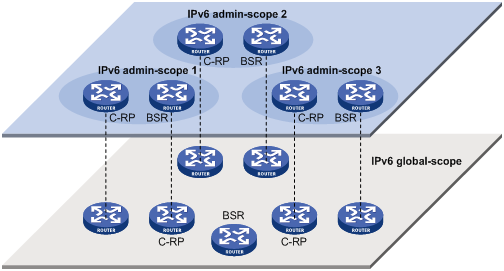
As shown in Figure 10, for the IPv6 multicast groups with the same scope field value, the IPv6 admin-scope zones must be geographically separated and isolated. The IPv6 global-scoped zone includes all routers in the IPv6 PIM-SM domain or IPv6 BIDIR-PIM domain. IPv6 multicast packets that do not belong to any IPv6 admin-scope zones are forwarded in the entire IPv6 PIM-SM domain or IPv6 BIDIR-PIM domain.
· In view of the scope field values:
In terms of the scope field values, the scope field in an IPv6 multicast group address shows which zone the IPv6 multicast group belongs to.
Figure 11 IPv6 multicast address format

An IPv6 admin-scoped zone with a larger scope field value contains an IPv6 admin-scoped zone with a smaller scope field value. The zone with the scope field value of E is the IPv6 global-scoped zone. Table 1 lists the possible values of the scope field.
Table 1 Values of the Scope field
|
Meaning |
Remarks |
|
|
0, F |
Reserved |
N/A |
|
1 |
Interface-local scope |
N/A |
|
2 |
Link-local scope |
N/A |
|
3 |
Subnet-local scope |
IPv6 admin-scoped zone. |
|
4 |
Admin-local scope |
IPv6 admin-scoped zone. |
|
5 |
Site-local scope |
IPv6 admin-scoped zone. |
|
6, 7, 9 through D |
Unassigned |
IPv6 admin-scoped zone. |
|
8 |
Organization-local scope |
IPv6 admin-scoped zone. |
|
E |
Global scope |
IPv6 global-scoped zone. |
IPv6 PIM-SSM overview
The ASM model includes IPv6 PIM-DM and IPv6 PIM-SM. The SSM model can be implemented by leveraging part of the IPv6 PIM-SM technique. It is also called "IPv6 PIM-SSM."
The SSM model provides a solution for source-specific multicast. It maintains the relationship between hosts and routers through MLDv2.
In actual applications, part of MLDv2 and IPv6 PIM-SM techniques are adopted to implement the SSM model. In the SSM model, because receivers have located an IPv6 multicast source, no RP or RPT is required, and no source registration process is required for discovering IPv6 multicast sources in other IPv6 PIM domains.
The operating mechanism of IPv6 PIM-SSM is summarized as follows:
Neighbor discovery
IPv6 PIM-SSM uses the same neighbor discovery mechanism as IPv6 PIM-SM. For more information, see "Neighbor discovery."
DR election
IPv6 PIM-SSM uses the same DR election mechanism as IPv6 PIM-SM. For more information, see "DR election."
SPT building
The decision to build an RPT for IPv6 PIM-SM or an SPT for IPv6 PIM-SSM depends on whether the IPv6 multicast group that the receiver wants to join falls into the IPv6 SSM group range (FF3x::/32 reserved by IANA, where "x" represents any legal address scope).
Figure 12 SPT building in IPv6 PIM-SSM
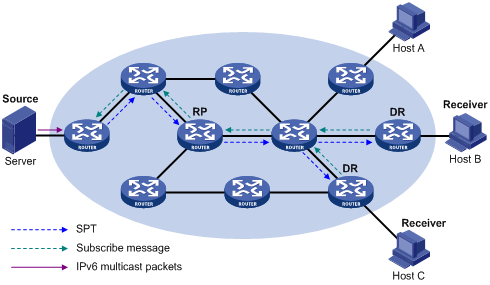
As shown in Figure 12, Host B and Host C are receivers. They send MLDv2 report messages to their DRs to express their interest in the multicast information that the IPv6 multicast source S sends to the IPv6 multicast group G.
After receiving a report message, the DR first checks whether the group address in the message falls into the IPv6 SSM group range and does the following:
· If the group address falls into the IPv6 SSM group range, the DR sends a subscribe message hop by hop toward the IPv6 multicast source S. All routers along the path from the DR to the IPv6 multicast source create an (S, G) entry so as to build an SPT, which is rooted the IPv6 multicast source S and has the receivers as its leaves. This SPT is the transmission channel in IPv6 PIM-SSM.
· If the group address does not fall into the IPv6 SSM group range, the receiver-side DR sends a (*, G) join message to the RP, and the IPv6 multicast source registers with the source-side DR.
In IPv6 PIM-SSM, the term "channel" refers to an IPv6 multicast group, and the term "subscribe message" refers to a join message.
Relationship among IPv6 PIM protocols
In an IPv6 PIM network, IPv6 PIM-DM cannot run together with IPv6 PIM-SM, IPv6 BIDIR-PIM, or IPv6 PIM-SSM. However, IPv6 PIM-SM, IPv6 BIDIR-PIM, and IPv6 PIM-SSM can run together. Figure 13 shows how the device selects one protocol from among them for a receiver trying to join a group.
For more information about MLD SSM mapping, see "Configuring MLD."
Figure 13 Relationship among IPv6 PIM protocols
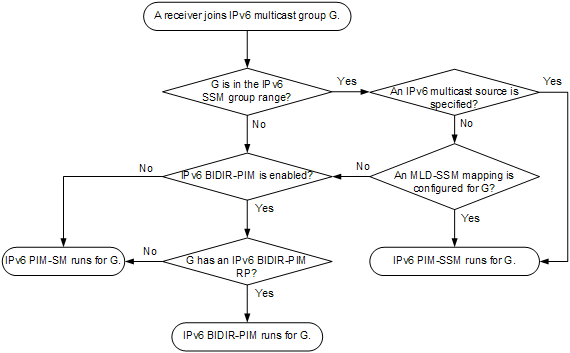
Protocols and standards
· RFC 3973, Protocol Independent Multicast-Dense Mode (PIM-DM): Protocol Specification(Revised)
· RFC 4601, Protocol Independent Multicast-Sparse Mode (PIM-SM): Protocol Specification (Revised)
· RFC 3956, Embedding the Rendezvous Point (RP) Address in an IPv6 Multicast Address
· RFC 5015, Bidirectional Protocol Independent Multicast (BIDIR-PIM)
· RFC 5059, Bootstrap Router (BSR) Mechanism for Protocol Independent Multicast (PIM)
· RFC 4607, Source-Specific Multicast for IP
· Draft-ietf-ssm-overview-05, An Overview of Source-Specific Multicast (SSM)
Configuring IPv6 PIM-DM
This section describes how to configure IPv6 PIM-DM.
IPv6 PIM-DM configuration task list
|
Task at a glance |
|
(Required.) Enabling IPv6 PIM-SM |
|
(Optional.) Enabling the state refresh feature |
|
(Optional.) Configuring state refresh parameters |
|
(Optional.) Configuring IPv6 PIM-DM graft retry timer |
|
(Optional.) Configuring common IPv6 PIM features |
Configuration prerequisites
Before you configure IPv6 PIM-DM, configure an IPv6 unicast routing protocol so that all devices in the domain are interoperable at the network layer.
Enabling IPv6 PIM-DM
Enable IPv6 multicast routing before configuring IPv6 PIM.
With IPv6 PIM-DM enabled on interfaces, routers can establish IPv6 PIM neighbor relationship and process IPv6 PIM messages from their IPv6 PIM neighbors. When you deploy an IPv6 PIM-DM domain, enable IPv6 PIM-DM on all non-border interfaces of routers.
|
|
IMPORTANT: All the interfaces on a device must operate in the same IPv6 PIM mode. |
To enable IPv6 PIM-DM:
|
Step |
Command |
Remarks |
|
1. Enter system view. |
system-view |
N/A |
|
2. Enable IPv6 multicast routing. |
ipv6 multicast routing-enable |
By default, IPv6 multicast routing is disabled. |
|
3. Enter interface view. |
interface interface-type interface-number |
N/A |
|
4. Enable IPv6 PIM-DM. |
ipv6 pim dm |
By default, IPv6 PIM-DM is disabled. |
Enabling the state refresh feature
Pruned interfaces resume multicast forwarding when the pruned state times out. To prevent this, the router directly connected with the IPv6 multicast source periodically sends an (S, G) state refresh message, which is forwarded hop-by-hop along the initial flooding path of the IPv6 PIM-DM domain, to refresh the prune timer state of all the routers on the path. A shared-media subnet can have the state refresh feature only if the state refresh feature is enabled on all IPv6 PIM routers on the subnet.
To enable the state refresh feature on all routers in IPv6 PIM-DM domain:
|
Step |
Command |
Remarks |
|
1. Enter system view. |
system-view |
N/A |
|
2. Enter interface view. |
interface interface-type interface-number |
N/A |
|
3. Enable the state refresh feature. |
ipv6 pim state-refresh-capable |
By default, the state refresh feature is enabled. |
Configuring state refresh parameters
The router directly connected with the IPv6 multicast source periodically sends state refresh messages. You can configure the interval for sending such messages on that router.
A router might receive duplicate state refresh messages within a short time. To prevent this situation, you can configure the amount of time that the router must wait before receiving the next state refresh message. If the router receives a new state refresh message within the specified waiting time, it discards it. If this timer times out, the router accepts a new state refresh message, refreshes its own IPv6 PIM-DM state, and resets the waiting timer.
The hop limit value of a state refresh message decrements by 1 whenever it passes a router before it is forwarded to the downstream node until the hop limit value comes down to 0. In a small network, a state refresh message might cycle in the network. To control the propagation scope of state refresh messages, configure an appropriate hop limit value based on the network size on the router directly connected with the IPv6 multicast source.
To configure state refresh parameters:
|
Step |
Command |
Remarks |
|
1. Enter system view. |
system-view |
N/A |
|
2. Enter IPv6 PIM view. |
ipv6 pim |
N/A |
|
3. Configure the interval to send state refresh messages. |
state-refresh-interval interval |
By default, the interval to send refresh messages is 60 seconds. |
|
4. Configure the time to wait before receiving a new state refresh message. |
state-refresh-rate-limit time |
By default, the waiting time is 30 seconds. |
|
5. Configure the hop limit value of state refresh messages. |
state-refresh-hoplimit hoplimit-value |
By default, the hop limit value of state refresh messages is 255. |
Configuring IPv6 PIM-DM graft retry timer
In IPv6 PIM-DM, graft is the only type of message that uses the acknowledgment mechanism. In an IPv6 PIM-DM domain, if a router does not receive a graft-ack message from the upstream router within the specified time after it sends a graft message, the router keeps sending new graft messages at a configurable interval (graft retry timer) until it receives a graft-ack message from the upstream router. For more information about the configuration of other timers in IPv6 PIM-DM, see "Configuring common IPv6 PIM timers."
To configure the IPv6 PIM-DM graft retry timer:
|
Step |
Command |
Remarks |
|
1. Enter system view. |
system-view |
N/A |
|
2. Enter interface view. |
interface interface-type interface-number |
N/A |
|
3. Configure the graft retry timer. |
ipv6 pim timer graft-retry interval |
By default, the graft retry timer is 3 seconds. |
Configuring IPv6 PIM-SM
IPv6 PIM-SM configuration task list
|
Task at a glance |
|
|
(Required.) Enabling IPv6 PIM-SM |
|
|
(Required.) Configuring an RP: NOTE: Perform at least one of the tasks. In a network with a static RP, skip the task of configuring a BSR. |
|
|
Configure a BSR: · (Required.) Configuring a C-BSR · (Optional.) Configuring an IPv6 PIM domain border · (Optional.) Disabling the BSM semantic fragmentation function |
|
|
(Optional.) Configuring IPv6 multicast source registration |
|
|
(Optional.) Configuring switchover to SPT |
|
|
(Optional.) Configuring common IPv6 PIM features |
Configuration prerequisites
Before you configure IPv6 PIM-SM, configure an IPv6 unicast routing protocol so that all devices in the domain are interoperable at the network layer.
Enabling IPv6 PIM-SM
Enable IPv6 multicast routing before configuring IPv6 PIM.
With IPv6 PIM-SM enabled on interfaces, routers can establish IPv6 PIM neighbor relationship and process IPv6 PIM messages from their IPv6 PIM neighbors. When you deploy an IPv6 PIM-SM domain, H3C recommends enabling IPv6 PIM-SM on all non-border interfaces.
|
|
IMPORTANT: All the interfaces on the same router must operate in the same IPv6 PIM mode. |
To enable IPv6 PIM-SM:
|
Step |
Command |
Remarks |
|
1. Enter system view. |
system-view |
N/A |
|
2. Enable IPv6 multicast routing. |
ipv6 multicast routing-enable |
By default, IPv6 multicast routing is disabled. |
|
3. Enter interface view. |
interface interface-type interface-number |
N/A |
|
4. Enable IPv6 PIM-SM. |
ipv6 pim sm |
By default, IPv6 PIM-SM is disabled. |
Configuring an RP
An RP can serve multiple IPv6 multicast groups or all IPv6 multicast groups. However, only one RP can forward IPv6 multicast traffic for an IPv6 multicast group at a moment.
An RP can be manually configured or dynamically elected through the BSR mechanism. For a large-scaled IPv6 PIM network, configuring static RPs is a tedious job. Generally, static RPs are backups for dynamic RPs to enhance the robustness and operational manageability on an IPv6 multicast network.
Configuring a static RP
If only one dynamic RP exists on a network, you can configure a static RP to avoid communication interruption caused by single-point failures. It can also avoid waste of bandwidth due to frequent message exchange between C-RPs and the BSR. To make the static RP operate properly, configure the same static RP on all routers in the IPv6 PIM-SM domain.
To configure a static RP:
|
Step |
Command |
Remarks |
|
1. Enter system view. |
system-view |
N/A |
|
2. Enter IPv6 PIM view. |
ipv6 pim |
N/A |
|
3. Configure a static RP for IPv6 PIM-SM. |
static-rp ipv6-rp-address [ acl6-number | bidir | preferred ] * |
By default, no static RP is configured. |
Configuring a C-RP
In an IPv6 PIM-SM domain, if you want a router to become the RP, you can configure the router as a C-RP. The BSR collects the C-RP information according to the received advertisement messages from C-RPs or the auto-RP announcements from other routers, and organizes the C-RP information into the RP-set information, which is flooded throughout the entire network. Then, the other routers in the network can determine the RPs for different IPv6 multicast group ranges based on the RP-set information. H3C recommends configuring C-RPs on backbone routers.
To enable the BSR to distribute the RP-set information in the PIM-SM domain, the C-RPs must periodically send advertisement messages to the BSR. The BSR learns the C-RP information, encapsulates the C-RP information and its own IPv6 address in a BSM, and floods the BSM to all IPv6 PIM routers in the domain.
An advertisement message contains a holdtime option, which defines the C-RP lifetime for the advertising C-RP. After the BSR receives an advertisement message from a C-RP, it starts a timer for the C-RP. If the BSR does not receive any advertisement message when the timer expires, it regards the C-RP failed or unreachable.
To guard against C-RP spoofing, you must configure a legal C-RP address range and the multicast group range to serve on the BSR. In addition, because every C-BSR might become the BSR, you must configure the same filtering policy on all C-BSRs in the IPv6 PIM-SM domain.
When you configure a C-RP, reserve a relatively large bandwidth between the C-RP and the other devices in the IPv6 PIM-SM domain.
To configure a C-RP:
|
Step |
Command |
Remarks |
|
1. Enter system view. |
system-view |
N/A |
|
2. Enter IPv6 PIM view. |
ipv6 pim |
N/A |
|
3. Configure a C-RP. |
c-rp ipv6-address [ advertisement-interval adv-interval | { group-policy acl6-number | scope scope-id } | holdtime hold-time | priority priority ] * |
By default, no C-RP is configured. |
|
4. (Optional.) Configure a legal C-RP address range and the IPv6 multicast group range to serve. |
crp-policy acl6-number |
By default, no restrictions are defined. |
Configuring a BSR
You must configure a BSR if C-RPs are configured to dynamically select the RP. In a network with a static RP, this configuration task is unnecessary.
An IPv6 PIM-SM domain can have only one BSR, but must have at least one C-BSR. Any router can be configured as a C-BSR. Elected from C-BSRs, the BSR is responsible for collecting and advertising RP information in the IPv6 PIM-SM domain.
Configuring a C-BSR
C-BSRs should be configured on routers on the backbone network. The BSR election process is summarized as follows:
· Initially, each C-BSR regards itself as the BSR of the IPv6 PIM-SM domain send BSMs to other routers in the domain.
· When a C-BSR receives the BSM from another C-BSR, it compares its own priority with the priority carried in the message. The C-BSR with a higher priority wins the BSR election. If a tie exists in the priority, the C-BSR with a higher IPv6 address wins. The loser uses the winner's BSR address to replace its own BSR address and no longer regards itself as the BSR, and the winner retains its own BSR address and continues to regard itself as the BSR.
In an IPv6 PIM-SM domain, the BSR collects C-RP information from the received advertisement messages from the C-RPs, encapsulates the C-RP information in the RP-set information, and distributes the RP-set information to all routers in the IPv6 PIM-SM domain. All routers use the same hash algorithm to get an RP for a specific IPv6 multicast group.
Configuring a legal BSR address range enables filtering of BSMs based on the address range, thereby preventing a maliciously configured host from masquerading as a BSR. The same configuration must be made on all routers in the IPv6 PIM-SM domain. The following describes the typical BSR spoofing cases and the corresponding preventive measures:
· Some maliciously configured hosts can forge BSMs to fool routers and change RP mappings. Such attacks often occur on border routers. Because a BSR is inside the network whereas hosts are outside the network, you can protect a BSR against attacks from external hosts by enabling the border routers to perform neighbor checks and RPF checks on BSMs and to discard unwanted messages.
· When an attacker controls a router in the network or when an illegal router is present in the network, the attacker can configure the router as a C-BSR and make it win the BSR election to advertise RP information in the network. After a router is configured as a C-BSR, it automatically floods the network with BSMs. Because a BSM has a hop limit value of 1, the whole network will not be affected as long as the neighbor router discards these BSMs. Therefore, with a legal BSR address range configured on all routers in the network, all these routers can discard BSMs from out of the legal address range.
These preventive measures can partially protect the BSR in a network. However, if an attacker controls a legal BSR, the problem still exists.
When you configure a C-BSR, reserve a relatively large bandwidth between the C-BSR and the other devices in the IPv6 PIM-SM domain.
To configure a C-BSR:
|
Step |
Command |
Remarks |
|
1. Enter system view. |
system-view |
N/A |
|
2. Enter IPv6 PIM view. |
ipv6 pim |
N/A |
|
3. Configure a C-BSR. |
c-bsr ipv6-address [ scope scope-id ] [ hash-length hash-length | priority priority ] * |
By default, no C-BSR is configured. |
|
4. (Optional.) Configure a legal BSR address range. |
bsr-policy acl6-number |
By default, no restrictions are defined. |
Configuring an IPv6 PIM domain border
As the administrative core of an IPv6 PIM-SM domain, the BSR sends the collected RP-set information in the form of bootstrap messages to all routers in the IPv6 PIM-SM domain.
An IPv6 PIM domain border is a bootstrap message boundary. Each BSR has its specific service scope. IPv6 PIM domain border interfaces partition a network into different IPv6 PIM-SM domains. Bootstrap messages cannot cross a domain border in either direction.
Perform the following configuration on routers that you want to configure as an IPv6 PIM domain border.
To configure an IPv6 PIM border domain:
|
Step |
Command |
Remarks |
|
1. Enter system view. |
system-view |
N/A |
|
2. Enter interface view. |
interface interface-type interface-number |
N/A |
|
3. Configuring an IPv6 PIM domain border. |
ipv6 pim bsr-boundary |
By default, no IPv6 PIM domain border is configured. |
Disabling the BSM semantic fragmentation function
Generally, a BSR periodically advertises the RP-set information in BSMs within the IPv6 PIM-SM domain. It encapsulates a BSM in an IPv6 datagram and might fragment the datagram if the message exceeds the MTU. In this case, loss of a single IP fragment leads to unavailability of the entire message.
Semantic fragmentation of BSMs can solve this issue. When a BSM exceeds the MTU, it is split to multiple BSM fragments (BSMFs).
· If the RP-set information for an IPv6 multicast group range is carried in one BSMF, a non-BSR router directly updates the RP-set information for the group range after receiving the BSMF.
· If the RP-set information for an IPv6 multicast group range is carried in multiple BSMFs, a non-BSR router updates the RP-set information for the group range after receiving all these BSMFs. Because the RP-set information contained in each segment is different, loss of some IP fragments does not result in dropping of the entire BSM.
The BSM semantic fragmentation function is enabled by default. A device that does not support this function might regard a fragment as a BSM and thus learns only part of the RP-set information. Therefore, if such devices exist in the IPv6 PIM-SM domain, you must disable the BSM semantic fragmentation function on the C-BSRs.
To disable the BSM semantic fragmentation function:
|
Step |
Command |
Remarks |
|
1. Enter system view. |
system-view |
N/A |
|
2. Enter IPv6 PIM view. |
ipv6 pim |
N/A |
|
3. Disable the BSM semantic fragmentation function. |
undo bsm-fragment enable |
By default, BSM semantic fragmentation is enabled. |
|
|
NOTE: Generally, a BSR performs BSM semantic fragmentation according to the MTU of its BSR interface. However, for BSMs originated due to learning of a new IPv6 PIM neighbor, semantic fragmentation is performed according to the MTU of the interface that sends the BSMs. |
Configuring IPv6 multicast source registration
In view of information integrity of a register message in the transmission process, you can configure the device to calculate the checksum based on the entire register message. However, to reduce the workload of encapsulating data in register messages and for the sake of interoperability, do not use this checksum calculation method.
To configure IPv6 multicast source registration:
|
Step |
Command |
Remarks |
|
1. Enter system view. |
system-view |
N/A |
|
2. Enter IPv6 PIM view. |
ipv6 pim |
N/A |
|
3. Configure a filtering rule for register messages. |
register-policy acl6-number |
By default, no register filtering rule exists. |
|
4. Configure the device to calculate the checksum based on the entire register message. |
register-whole-checksum |
By default, the device calculates the checksum based on the header of a register message. |
Configuring switchover to SPT
|
|
CAUTION: If the router is an RP, disabling switchover to SPT might cause multicast traffic forwarding failures on the source-side DR. When disabling switchover to SPT, be sure you fully understand its impact on your network. |
To configure switchover to SPT
|
Step |
Command |
Remarks |
|
1. Enter system view. |
system-view |
N/A |
|
2. Enter IPv6 PIM view. |
ipv6 pim |
N/A |
|
3. Configure the criteria for triggering a switchover to SPT. |
spt-switch-threshold { immediacy | infinity } [ group-policy acl6-number ] |
By default, both the receiver-side DR and RP can immediately trigger the switchover to SPT after receiving the first multicast packet. |
Configuring common IPv6 PIM features
Configuration task list
|
Task at a glance |
|
(Optional.) Configuring an IPv6 multicast data filter |
|
(Optional.) Configuring a hello message filter |
|
(Optional.) Configuring IPv6 PIM hello message options |
|
(Optional.) Configuring common IPv6 PIM timers |
|
(Optional.) Setting the maximum size of each join or prune message |
Configuration prerequisites
Before you configure common IPv6 PIM features, complete the following tasks:
· Configure an IPv6 unicast routing protocol so that all devices in the domain are interoperable at the network layer.
· Configure IPv6 PIM-DM, IPv6 PIM-SM, or IPv6 PIM-SSM.
Configuring an IPv6 multicast data filter
In either an IPv6 PIM-DM domain or an IPv6 PIM-SM domain, routers can check passing-by IPv6 multicast data and determine whether to continue forwarding the IPv6 multicast data based on the configured filtering rules. In other words, an IPv6 PIM router can act as an IPv6 multicast data filter, which can help implement traffic control and also control the information available to downstream receivers.
A filter can filter not only independent IPv6 multicast data but also IPv6 multicast data encapsulated in register messages. Generally, a filter nearer to the IPv6 multicast source has a better filtering effect.
To configure an IPv6 multicast data filter:
|
Step |
Command |
Remarks |
|
1. Enter system view. |
system-view |
N/A |
|
2. Enter IPv6 PIM view. |
ipv6 pim |
N/A |
|
3. Configure an IPv6 multicast data filter: |
source-policy acl6-number |
By default, no IPv6 multicast data filter is configured. |
Configuring a hello message filter
Along with the wide applications of IPv6 PIM, the security requirement for the protocol is becoming increasingly demanding. The establishment of correct IPv6 PIM neighboring relationship is a prerequisite for secure application of IPv6 PIM.
To guard against IPv6 PIM message attacks, you can configure a legal source address range for hello messages on interfaces of routers to ensure the correct IPv6 PIM neighboring relationship.
To configure a hello message filter:
|
Step |
Command |
Remarks |
|
1. Enter system view. |
system-view |
N/A |
|
2. Enter interface view. |
interface interface-type interface-number |
N/A |
|
3. Configure a hello message filter. |
ipv6 pim neighbor-policy acl6-number |
By default, no hello message filter exists. If an IPv6 PIM neighbor's hello messages cannot pass the filter, the neighbor is automatically removed when its maximum number of hello attempts is reached. |
Configuring IPv6 PIM hello message options
In either an IPv6 PIM-DM domain or an IPv6 PIM-SM domain, hello messages exchanged among routers contain the following configurable options:
· DR_Priority (for IPv6 PIM-SM only)—Priority for DR election. The device with the highest priority wins the DR election. You can configure this option for all the routers in a shared-media LAN that directly connects to the IPv6 multicast source or the receivers.
· Holdtime—IPv6 PIM neighbor lifetime. If a router receives no hello message from a neighbor when the neighbor lifetime expires, it regards the neighbor failed or unreachable.
· LAN_Prune_Delay—Delay of forwarding prune messages on a shared-media LAN. This option consists of LAN delay (namely, prune message delay), override interval, and neighbor tracking support (namely, the capability to disable join message suppression).
The prune message delay defines the delay time for a router to forward a received prune message to the upstream routers. The override interval defines a time period for a downstream router to override a prune message. If the prune message delay or override interval on different IPv6 PIM routers on a shared-media LAN are different, the largest value takes effect.
A router does not immediately prune an interface after it receives a prune message from the interface. Instead, it starts a timer (the prune message delay plus the override interval). If interface receives a join message before the override interval expires, the router does not prune the interface. Otherwise, the router prunes the interface when the timer (the prune message delay plus the override interval) expires.
You can enable the neighbor tracking function (or disable the join message suppression function) on an upstream router to track the states of the downstream nodes that have sent the join message and the joined state holdtime timer has not expired. If you want to enable the neighbor tracking function, you must enable it on all IPv6 PIM routers on a shared-media LAN. Otherwise, the upstream router cannot track join messages from every downstream routers..
· Generation ID—A router generates a generation ID for hello messages when an interface is enabled with IPv6 PIM. The generation ID is a random value, but only changes when the status of the router changes. If an IPv6 PIM router finds that the generation ID in a hello message from the upstream router has changed, it assumes that the status of the upstream router has changed. In this case, it sends a join message to the upstream router for status update. You can configure an interface to drop hello messages without the generation ID options to promptly know the status of an upstream router.
You can configure hello message options in IPv6 PIM view or interface view. The configurations made in IPv6 PIM view are effective on all interfaces and the configurations made in interface view are effective on only the current interface. If you configure hello message options in both IPv6 PIM view and interface view, the configuration in interface view always takes precedence.
Configuring hello message options globally
|
Step |
Command |
Remarks |
|
1. Enter system view. |
system-view |
N/A |
|
2. Enter IPv6 PIM view. |
ipv6 pim |
N/A |
|
3. Set the DR priority. |
hello-option dr-priority priority |
By default, the DR priority is 1. |
|
4. Set the neighbor lifetime. |
hello-option holdtime time |
By default, the neighbor lifetime is 105 seconds. |
|
5. Set the prune message delay. |
hello-option lan-delay delay |
By default, the prune message delay is 500 milliseconds. |
|
6. Set the override interval. |
hello-option override-interval interval |
By default, the override interval is 2500 milliseconds. |
|
7. Enable the neighbor tracking function. |
hello-option neighbor-tracking |
By default, the neighbor tracking function is disabled. |
Configuring hello message options on an interface
|
Step |
Command |
Remarks |
|
1. Enter system view. |
system-view |
N/A |
|
2. Enter interface view. |
interface interface-type interface-number |
N/A |
|
3. Set the DR priority. |
ipv6 pim hello-option dr-priority priority |
By default, the DR priority is 1. |
|
4. Set the neighbor lifetime. |
ipv6 pim hello-option holdtime time |
By default, the neighbor lifetime is 105 seconds. |
|
5. Set the prune delay. |
ipv6 pim hello-option lan-delay delay |
By default, the prune delay is 500 milliseconds. |
|
6. Set the override interval. |
ipv6 pim hello-option override-interval interval |
By default, the override interval is 2500 milliseconds. |
|
7. Enable the neighbor tracking function. |
ipv6 pim hello-option neighbor-tracking |
By default, the neighbor tracking function is disabled. |
|
8. Enable dropping hello messages without the Generation ID option. |
ipv6 pim require-genid |
By default, an interface accepts hello message without the Generation ID option. |
Configuring common IPv6 PIM timers
IPv6 PIM routers periodically send hello messages to discover IPv6 PIM neighbors, and maintain IPv6 PIM neighbor relationship.
After receiving a hello message, an IPv6 PIM router waits for a random time period before sending a hello message. This random time period is smaller than the maximum delay for sending hello messages, and it can avoids collisions that might occur when multiple IPv6 PIM routers send hello messages simultaneously.
An IPv6 PIM router periodically sends join/prune messages to its upstream routers for state update. A join/prune message contains the joined/pruned state timeout value, and an upstream router uses this value to set a timeout timer for the joined state or pruned state of the downstream interfaces.
When a router fails to receive subsequent IPv6 multicast data from the IPv6 multicast source S, the router does not immediately remove the corresponding (S, G) entry. Instead, it maintains the (S, G) entry for a period of time (namely, the IPv6 multicast source lifetime) before deleting the (S, G) entry.
You can configure common IPv6 PIM timers in IPv6 PIM view or interface view. The configurations made in IPv6 PIM view are effective on all interfaces and the configurations made in interface view are effective on only the current interface. If you configure hello message options in both IPv6 PIM view and interface view, the configuration in interface view always takes precedence.
|
|
TIP: For a network without special requirements, H3C recommends using the defaults. |
Configuring common IPv6 PIM timers globally
|
Step |
Command |
Remarks |
|
1. Enter system view. |
system-view |
N/A |
|
2. Enter IPv6 PIM view. |
ipv6 pim |
N/A |
|
3. Set the interval to send hello messages. |
timer hello interval |
By default, the interval to send hello messages is 30 seconds. |
|
4. Set the interval to send join/prune messages. |
timer join-prune interval |
By default, the interval to send join/prune messages is 60 seconds. |
|
5. Set the joined/pruned state holdtime timer. |
holdtime join-prune time |
By default, the joined/pruned state holdtime timer is 210 seconds. |
|
6. Set the IPv6 multicast source lifetime. |
source-lifetime delay |
By default, the IPv6 multicast source lifetime is 210 seconds. |
Configuring common IPv6 PIM timers on an interface
|
Step |
Command |
Remarks |
|
1. Enter system view. |
system-view |
N/A |
|
2. Enter interface view. |
interface interface-type interface-number |
N/A |
|
3. Set the interval to send hello messages. |
ipv6 pim timer hello interval |
By default, the interval to send hello messages is 30 seconds. |
|
4. Set the maximum delay for sending hello messages. |
ipv6 pim triggered-hello-delay delay |
By default, the maximum delay for sending hello messages is 5 seconds. |
|
5. Set the interval to send join/prune messages. |
ipv6 pim timer join-prune interval |
By default, the interval to send join/prune messages is 60 seconds. |
|
6. Set the joined/pruned state holdtime timer. |
ipv6 pim holdtime join-prune time |
By default, the joined/pruned state holdtime timer is 210 seconds. |
Setting the maximum size of each join or prune message
The loss of an oversized join or prune message might result in loss of massive information. You can set a small value for the size of each join or prune message to reduce the impact.
To set the maximum size of each join or prune message:
|
Step |
Command |
Remarks |
|
1. Enter system view. |
system-view |
N/A |
|
2. Enter IPv6 PIM view. |
ipv6 pim |
N/A |
|
3. Set the maximum size of each join or prune message. |
jp-pkt-size size |
By default, the maximum size of a join or prune message is 8100 bytes. |
Displaying and maintaining IPv6 PIM
Execute display commands in any view and reset commands in user view.
|
Task |
Command |
|
Display BSR information in the IPv6 PIM-SM domain. |
display ipv6 pim bsr-info |
|
Display information about the routes used by IPv6 PIM. |
display ipv6 pim claimed-route [ ipv6-source-address ] |
|
Display C-RP information in the IPv6 PIM-SM domain. |
display ipv6 pim c-rp [ local ] |
|
Display IPv6 PIM information on an interface. |
display ipv6 pim interface [ interface-type interface-number ] [ verbose ] |
|
Display IPv6 PIM neighbor information. |
display ipv6 pim neighbor [ ipv6-neighbor-address | interface interface-type interface-number | verbose ] * |
|
Display IPv6 PIM routing table information. |
display ipv6 pim routing-table [ ipv6-group-address [ prefix-length ] | ipv6-source-address [ prefix-length ] | flags flag-value | fsm | incoming-interface interface-type interface-number | mode mode-type | outgoing-interface { exclude | include | match } interface-type interface-number ] * |
|
Display RP information in the IPv6 PIM-SM domain. |
display ipv6 pim rp-info [ ipv6-group-address ] |
IPv6 PIM configuration examples
|
|
IMPORTANT: By default, Ethernet interfaces, VLAN interfaces, and aggregate interfaces are in the state of DOWN. To configure such an interface, use the undo shutdown command to bring it up first. |
IPv6 PIM-DM configuration example
Network requirements
The receiver hosts receive VOD information through multicast. The receiver groups of different organizations form stub networks, and one or more receiver hosts exist in each stub network. The entire IPv6 PIM domain is operating in the dense mode.
Host A and Host C are multicast receivers in two stub networks N1 and N2.
MLDv1 runs between Switch A and N1 and between Switch B, Switch C, and N2.
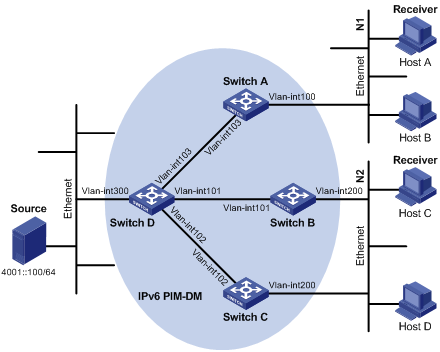
|
Interface |
IPv6 address |
Device |
Interface |
IPv6 address |
|
|
Switch A |
VLAN-interface 100 |
1001::1/64 |
Switch D |
VLAN-interface 300 |
4001::1/64 |
|
|
VLAN-interface 103 |
1002::1/64 |
|
VLAN-interface 103 |
1002::2/64 |
|
Switch B |
VLAN-interface 200 |
2001::1/64 |
|
VLAN-interface 101 |
2002::2/64 |
|
|
VLAN-interface 101 |
2002::1/64 |
|
VLAN-interface 102 |
3001::2/64 |
|
Switch C |
VLAN-interface 200 |
2001::2/64 |
|
|
|
|
|
VLAN-interface 102 |
3001::1/64 |
|
|
|
Configuration procedure
1. Assign the IPv6 address and prefix length to each interface according to Figure 14. (Details not shown.)
2. Configure OSPFv3 on the switches in the IPv6 PIM-DM domain to make sure they are interoperable at the network layer and routing information among the switches is dynamically updated. (Details not shown.)
3. Enable IPv6 multicast routing, MLD, and IPv6 PIM-DM:
# On Switch A, enable IPv6 multicast routing, enable MLD on VLAN-interface 100, and enable IPv6 PIM-DM on each interface.
<SwitchA> system-view
[SwitchA] ipv6 multicast routing-enable
[SwitchA] interface vlan-interface 100
[SwitchA-Vlan-interface100] mld enable
[SwitchA-Vlan-interface100] ipv6 pim dm
[SwitchA-Vlan-interface100] quit
[SwitchA] interface vlan-interface 103
[SwitchA-Vlan-interface103] ipv6 pim dm
[SwitchA-Vlan-interface103] quit
# Enable IPv6 multicast routing, MLD, and IPv6 PIM-DM on Switch B and Switch C in the same way. (Details not shown.)
# On Switch D, enable IPv6 multicast routing, and enable IPv6 PIM-DM on each interface.
<SwitchD> system-view
[SwitchD] ipv6 multicast routing-enable
[SwitchD] interface vlan-interface 300
[SwitchD-Vlan-interface300] ipv6 pim dm
[SwitchD-Vlan-interface300] quit
[SwitchD] interface vlan-interface 103
[SwitchD-Vlan-interface103] ipv6 pim dm
[SwitchD-Vlan-interface103] quit
[SwitchD] interface vlan-interface 101
[SwitchD-Vlan-interface101] ipv6 pim dm
[SwitchD-Vlan-interface101] quit
[SwitchD] interface vlan-interface 102
[SwitchD-Vlan-interface102] ipv6 pim dm
[SwitchD-Vlan-interface102] quit
Verifying the configuration
# Display IPv6 PIM information on Switch D.
[SwitchD] display ipv6 pim interface
Interface NbrCnt HelloInt DR-Pri DR-Address
Vlan300 0 30 1 FE80::A01:201:1
(local)
Vlan103 0 30 1 FE80::A01:201:2
(local)
Vlan101 1 30 1 FE80::A01:201:3
(local)
Vlan102 1 30 1 FE80::A01:201:4
(local)
# Display IPv6 PIM neighboring relationship on Switch D.
[SwitchD] display ipv6 pim neighbor
Total Number of Neighbors = 3
Neighbor Interface Uptime Expires Dr-Priority
FE80::A01:101:1 Vlan103 00:04:00 00:01:29 1
FE80::B01:102:2 Vlan101 00:04:16 00:01:29 3
FE80::C01:103:3 Vlan102 00:03:54 00:01:17 5
Assume that Host A needs to receive the information addressed to IPv6 multicast group FF0E::101. After IPv6 multicast source 4001::100/64 sends IPv6 multicast packets to the IPv6 multicast group, an SPT is established through traffic flooding. Switches on the SPT path (Switch A and Switch D) have their (S, G) entries. Host A sends an MLD report to Switch A to join IPv6 multicast group, and a (*, G) entry is generated on Switch A. You can use the display ipv6 pim routing-table command to display the IPv6 PIM routing table information on each switch. For example:
# Display IPv6 PIM multicast routing table information on Switch A.
[SwitchA] display ipv6 pim routing-table
Total 1 (*, G) entry; 1 (S, G) entry
(*, FF0E::101)
Protocol: pim-dm, Flag: WC
UpTime: 00:01:24
Upstream interface: NULL
Upstream neighbor: NULL
RPF prime neighbor: NULL
Downstream interface(s) information:
Total number of downstreams: 1
1: Vlan-interface100
Protocol: mld, UpTime: 00:01:20, Expires: never
(4001::100, FF0E::101)
Protocol: pim-dm, Flag: ACT
UpTime: 00:01:20
Upstream interface: Vlan-interface103
Upstream neighbor: 1002::2
RPF prime neighbor: 1002::2
Downstream interface(s) information:
Total number of downstreams: 1
1: Vlan-interface100
Protocol: pim-dm, UpTime: 00:01:20, Expires: never
# Display IPv6 PIM multicast routing table information on Switch D.
[SwitchD] display ipv6 pim routing-table
Total 0 (*, G) entry; 1 (S, G) entry
(4001::100, FF0E::101)
Protocol: pim-dm, Flag: LOC ACT
UpTime: 00:02:19
Upstream interface: Vlan-interface300
Upstream neighbor: NULL
RPF prime neighbor: NULL
Downstream interface(s) information:
Total number of downstreams: 2
1: Vlan-interface103
Protocol: pim-dm, UpTime: 00:02:19, Expires: never
2: Vlan-interface102
Protocol: pim-dm, UpTime: 00:02:19, Expires: never
IPv6 PIM-SM non-scoped zone configuration example
Network requirements
As shown in Figure 15, the receiver hosts receive VOD information through multicast. The receivers of different subnets form stub networks, and at least one receiver host exist in each stub network. The entire IPv6 PIM-SM domain contains only one BSR.
Host A and Host C are multicast receivers in the stub networks N1 and N2.
VLAN-interface 105 on Switch D and VLAN-interface 102 on Switch E act as C-BSRs and C-RPs. The C-BSR on Switch E has a higher priority. The C-RPs server the IPv6 multicast group range FF0E::101/64. Modify the hash mask length to map the IPv6 multicast group range to the two C-RPs.
MLDv1 runs between Switch A and N1, and between Switch B, Switch C, and N2.
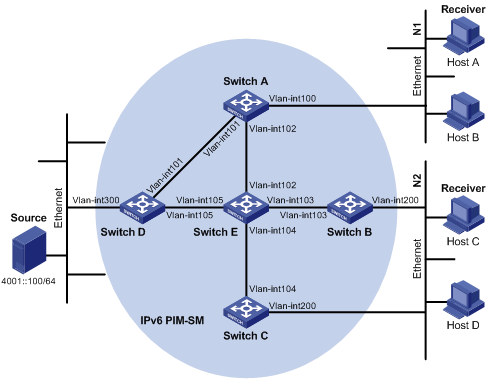
|
Device |
Interface |
IPv6 address |
Device |
Interface |
IPv6 address |
|
Switch A |
Vlan-int100 |
1001::1/64 |
Switch D |
Vlan-int300 |
4001::1/64 |
|
|
Vlan-int101 |
1002::1/64 |
|
Vlan-int101 |
1002::2/64 |
|
|
Vlan-int102 |
1003::1/64 |
|
Vlan-int105 |
4002::1/64 |
|
Switch B |
Vlan-int200 |
2001::1/64 |
Switch E |
Vlan-int104 |
3001::2/64 |
|
|
Vlan-int103 |
2002::1/64 |
|
Vlan-int103 |
2002::2/64 |
|
Switch C |
Vlan-int200 |
2001::2/64 |
|
Vlan-int102 |
1003::2/64 |
|
|
Vlan-int104 |
192.168.3.1/24 |
|
Vlan-int105 |
192.168.4.1/24 |
Configuration procedure
1. Assign an IPv6 address and prefix length to each interface according to Figure 15. (Details not shown.)
2. Enable OSPFv3 on all switches on the IPv6 PIM-SM network to make sure the network-layer on the IPv6 PIM-SM network is interoperable and the routing information among the switches can be dynamically updated. (Details not shown.)
3. Enable IPv6 multicast routing, MLD, and IPv6 PIM-SM:
# On Switch A, enable IPv6 multicast routing globally, enable MLD on VLAN-interface 100, and enable IPv6 PIM-SM on each interface.
<SwitchA> system-view
[SwitchA] ipv6 multicast routing-enable
[SwitchA] interface vlan-interface 100
[SwitchA-Vlan-interface100] mld enable
[SwitchA-Vlan-interface100] ipv6 pim sm
[SwitchA-Vlan-interface100] quit
[SwitchA] interface vlan-interface 101
[SwitchA-Vlan-interface101] ipv6 pim sm
[SwitchA-Vlan-interface101] quit
[SwitchA] interface vlan-interface 102
[SwitchA-Vlan-interface102] ipv6 pim sm
[SwitchA-Vlan-interface102] quit
# Enable IPv6 multicast routing, MLD, and IPv6 PIM-SM on Switch B and Switch C in the same way. (Details not shown.)
# Enable IPv6 multicast routing and IPv6 PIM-SM on Switch D and Switch E in the same way. (Details not shown.)
4. Configure a C-BSR and a C-RP:
# On Switch D, configure the service scope of RP advertisements, configure VLAN-interface 105 as a C-BSR and a C-RP, and set the hash mask length to 128 and the priority of the C-BSR to 10.
<SwitchD> system-view
[SwitchD] acl ipv6 number 2005
[SwitchD-acl6-basic-2005] rule permit source ff0e::101 64
[SwitchD-acl6-basic-2005] quit
[SwitchD] ipv6 pim
[SwitchD-pim6] c-bsr 4002::1 hash-length 128 priority 10
[SwitchD-pim6] c-rp 4002::1 group-policy 2005
[SwitchD-pim6] quit
# On Switch E, configure the service scope of RP advertisements, configure VLAN-interface 102 as a C-BSR and a C-RP, and set the hash mask length to 128 and the priority of the C-BSR to 20.
<SwitchE> system-view
[SwitchE] acl ipv6 number 2005
[SwitchE-acl6-basic-2005] rule permit source ff0e::101 64
[SwitchE-acl6-basic-2005] quit
[SwitchE] ipv6 pim
[SwitchE-pim6] c-bsr 1003::2 hash-length 128 priority 20
[SwitchE-pim6] c-rp 1003::2 group-policy 2005
[SwitchE-pim6] quit
Verifying the configuration
# Display IPv6 PIM information on Switch A.
[SwitchA] display ipv6 pim interface
Interface NbrCnt HelloInt DR-Pri DR-Address
Vlan100 0 30 1 FE80::A01:201:1
(local)
Vlan101 1 30 1 FE80::A01:201:2
Vlan102 1 30 1 FE80::A01:201:3
# Display BSR information on Switch A.
[SwitchA] display ipv6 pim bsr-info
Scope: non-scoped
State: Accept Preferred
Bootstrap timer: 00:01:46
Elected BSR address: 1003::2
Priority: 20
Hash mask length: 128
Uptime: 00:04:22
# Display BSR information on Switch D.
[SwitchD] display ipv6 pim bsr-info
Scope: non-scoped
State: Candidate
Bootstrap timer: 00:01:45
Elected BSR address: 1003::2
Priority: 20
Hash mask length: 128
Uptime: 00:05:26
Candidate BSR address: 4002::1
Priority: 10
Hash mask length: 128
# Display BSR information on Switch E.
[SwitchE] display ipv6 pim bsr-info
Scope: non-scoped
State: Elected
Bootstrap timer: 00:01:48
Elected BSR address: 1003::2
Priority: 20
Hash mask length: 128
Uptime: 00:01:10
Candidate BSR address: 1003::2
Priority: 20
Hash mask length: 128
# Display RP information on Switch A.
[SwitchA] display ipv6 pim rp-info
BSR RP information:
Scope: non-scoped
Group/MaskLen: FF0E::101/64
RP address Priority HoldTime Uptime Expires
1003::2 192 180 00:05:19 00:02:11
4002::1 192 180 00:05:19 00:02:11
IPv6 PIM-SM admin-scoped zone configuration example
Network requirements
As shown in Figure 16, receiver hosts receive VOD information through multicast. The entire IPv6 PIM-SM domain is divided into IPv6 admin-scoped zone 1, IPv6 admin-scoped zone 2, and the IPv6 global-scoped zone. Switch B, Switch C, and Switch D are ZBRs of the three zones, respectively.
Source 1 and Source 2 send different IPv6 multicast data to the IPv6 multicast group FF14::101. Host A receives the IPv6 multicast data only from Source 1, and Host B receives the IPv6 multicast data only from Source 2. Source 3 sends IPv6 multicast data to the IPv6 multicast group FF1E::202. Host C is an IPv6 multicast receiver for the IPv6 multicast group FF1E::202.
VLAN-interface 101 of Switch B acts as a C-BSR and a C-RP for IPv6 admin-scoped zone 1, and VLAN-interface 105 of Switch D acts as a C-BSR and a C-RP for IPv6 admin-scoped zone 2. Both of the two interfaces serve the IPv6 multicast groups with the scope field value of 4. VLAN-interface 109 of Switch F acts as a C-BSR and a C-RP for the IPv6 global-scoped zone, and it serves the IPv6 multicast groups with the scope field value of 14.
MLDv1 runs between Switch A, Switch E, Switch I, and the receivers that directly connect to them, respectively.
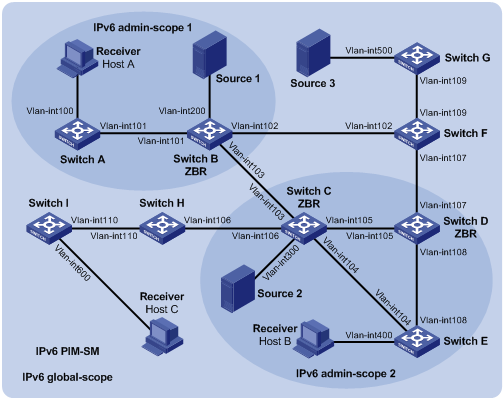
|
Device |
Interface |
IPv6 address |
Device |
Interface |
IPv6 address |
|
Switch A |
Vlan-int100 |
1001::1/64 |
Switch D |
Vlan-int105 |
3003::2/64 |
|
|
Vlan-int101 |
1002::1/64 |
|
Vlan-int108 |
6001::1/64 |
|
Switch B |
Vlan-int200 |
2001::1/64 |
|
Vlan-int107 |
6002::1/64 |
|
|
Vlan-int101 |
1002::2/64 |
Switch E |
Vlan-int400 |
7001::1/64 |
|
|
Vlan-int103 |
2002::1/64 |
|
Vlan-int104 |
3002::2/64 |
|
|
Vlan-int102 |
2003::1/64 |
|
Vlan-int108 |
6001::2/64 |
|
Switch C |
Vlan-int300 |
3001::1/64 |
Switch F |
Vlan-int109 |
8001::1/64 |
|
|
Vlan-int104 |
3002::1/64 |
|
Vlan-int107 |
6002::2/64 |
|
|
Vlan-int105 |
3003::1/64 |
|
Vlan-int102 |
2003::2/64 |
|
|
Vlan-int103 |
2002::2/64 |
Switch G |
Vlan-int500 |
9001::1/64 |
|
|
Vlan-int106 |
3004::1/64 |
|
Vlan-int109 |
8001::2/64 |
|
Switch H |
Vlan-int110 |
4001::1/64 |
Source 1 |
- |
2001::100/64 |
|
|
Vlan-int106 |
3004::2/64 |
Source 2 |
- |
3001::100/64 |
|
Switch I |
Vlan-int600 |
5001::1/64 |
Source 3 |
- |
9001::100/64 |
|
|
Vlan-int110 |
4001::2/64 |
|
|
|
Configuration procedure
1. Assign an IPv6 address and prefix length to each interface according to Figure 16. (Details not shown.)
2. Enable OSPFv3 on all switches on the IPv6 PIM-SM network to make sure the network-layer on the IPv6 PIM-SM network is interoperable and the routing information among the switches can be dynamically updated. (Details not shown.)
3. Enable IPv6 multicast routing, MLD, and IPv6 PIM-SM:
# On Switch A, enable IPv6 multicast routing globally, enable MLD on VLAN-interface 100, and enable IPv6 PIM-SM on each interface.
<SwitchA> system-view
[SwitchA] ipv6 multicast routing-enable
[SwitchA] interface vlan-interface 100
[SwitchA-Vlan-interface100] mld enable
[SwitchA-Vlan-interface100] ipv6 pim sm
[SwitchA-Vlan-interface100] quit
[SwitchA] interface vlan-interface 101
[SwitchA-Vlan-interface101] ipv6 pim sm
[SwitchA-Vlan-interface101] quit
# Enable IPv6 multicast routing, MLD, and IPv6 PIM-SM on Switch E and Switch I in the same way. (Details not shown.)
# On Switch B, enable IPv6 multicast routing globally, and enable IPv6 PIM-SM on each interface.
<SwitchB> system-view
[SwitchB] ipv6 multicast routing-enable
[SwitchB] interface vlan-interface 200
[SwitchB-Vlan-interface200] ipv6 pim sm
[SwitchB-Vlan-interface200] quit
[SwitchB] interface vlan-interface 101
[SwitchB-Vlan-interface101] ipv6 pim sm
[SwitchB-Vlan-interface101] quit
[SwitchB] interface vlan-interface 102
[SwitchB-Vlan-interface102] ipv6 pim sm
[SwitchB-Vlan-interface102] quit
[SwitchB] interface vlan-interface 103
[SwitchB-Vlan-interface103] ipv6 pim sm
[SwitchB-Vlan-interface103] quit
# Enable IPv6 multicast routing and IPv6 PIM-SM on Switch C, Switch D, Switch F, Switch G, and Switch H in the same way. (Details not shown.)
4. Configure IPv6 admin-scoped zone boundaries:
# On Switch B, configure VLAN-interface 102 and VLAN-interface 103 as the boundaries of IPv6 admin-scoped zone 1.
[SwitchB] interface vlan-interface 102
[SwitchB-Vlan-interface102] ipv6 multicast boundary scope 4
[SwitchB-Vlan-interface102] quit
[SwitchB] interface vlan-interface 103
[SwitchB-Vlan-interface103] ipv6 multicast boundary scope 4
[SwitchB-Vlan-interface103] quit
# On Switch C, configure VLAN-interface 103 and VLAN-interface 106 as the boundaries of IPv6 admin-scoped zone 2.
<SwitchC> system-view
[SwitchC] interface vlan-interface 103
[SwitchC-Vlan-interface103] ipv6 multicast boundary scope 4
[SwitchC-Vlan-interface103] quit
[SwitchC] interface vlan-interface 106
[SwitchC-Vlan-interface106] ipv6 multicast boundary scope 4
[SwitchC-Vlan-interface106] quit
# On Switch D, configure VLAN-interface 107 as the boundary of IPv6 admin-scoped zone 2.
<SwitchD> system-view
[SwitchD] interface vlan-interface 107
[SwitchD-Vlan-interface107] ipv6 multicast boundary scope 4
[SwitchD-Vlan-interface107] quit
5. Configure C-BSRs and C-RPs:
# On Switch B, configure the service scope of RP advertisements and configure VLAN-interface 101 as a C-BSR and a C-RP for IPv6 admin-scoped zone 1.
[SwitchB] ipv6 pim
[SwitchB-pim6] c-bsr 1002::2 scope 4
[SwitchB-pim6] c-rp 1002::2 scope 4
[SwitchB-pim6] quit
# On Switch D, configure the service scope of RP advertisements and configure VLAN-interface 105 as a C-BSR and a C-RP for IPv6 admin-scoped zone 2.
[SwitchD] ipv6 pim
[SwitchD-pim6] c-bsr 3003::2 scope 4
[SwitchD-pim6] c-rp 3003::2 scope 4
[SwitchD-pim6] quit
# On Switch F, configure VLAN-interface 109 as a C-BSR and a C-RP for the IPv6 global-scoped zone.
<SwitchF> system-view
[SwitchF] ipv6 pim
[SwitchF-pim6] c-bsr 8001::1
[SwitchF-pim6] c-rp 8001::1
[SwitchF-pim6] quit
Verifying the configuration
# Display BSR information on Switch B.
[SwitchB] display ipv6 pim bsr-info
Scope: non-scoped
State: Accept Preferred
Bootstrap timer: 00:01:25
Elected BSR address: 8001::1
Priority: 64
Hash mask length: 126
Uptime: 00:01:45
Scope: 4
State: Elected
Bootstrap timer: 00:00:06
Elected BSR address: 1002::2
Priority: 64
Hash mask length: 126
Uptime: 00:04:54
Candidate BSR address: 1002::2
Priority: 64
Hash mask length: 126
# Display BSR information on Switch D.
[SwitchD] display ipv6 pim bsr-info
Scope: non-scoped
State: Accept Preferred
Bootstrap timer: 00:01:25
Elected BSR address: 8001::1
Priority: 64
Hash mask length: 126
Uptime: 00:01:45
Scope: 4
State: Elected
Bootstrap timer: 00:01:25
Elected BSR address: 3003::2
Priority: 64
Hash mask length: 126
Uptime: 00:01:45
Candidate BSR address: 3003::2
Priority: 64
Hash mask length: 126
# Display BSR information on Switch F.
[SwitchF] display ipv6 pim bsr-info
Scope: non-scoped
State: Elected
Bootstrap timer: 00:00:49
Elected BSR address: 8001::1
Priority: 64
Hash mask length: 126
Uptime: 00:01:11
Candidate BSR address: 8001::1
Priority: 64
Hash mask length: 126
# Display RP information on Switch B.
[SwitchB] display ipv6 pim rp-info
BSR RP information:
Scope: non-scoped
Group/MaskLen: FF00::/8
RP address Priority HoldTime Uptime Expires
8001::1 192 180 00:01:14 00:02:46
Scope: 4
Group/MaskLen: FF04::/16
RP address Priority HoldTime Uptime Expires
1002::2 (local) 192 180 00:02:03 00:02:56
Group/MaskLen: FF14::/16
RP address Priority HoldTime Uptime Expires
1002::2 (local) 192 180 00:02:03 00:02:56
Group/MaskLen: FF24::/16
RP address Priority HoldTime Uptime Expires
1002::2 (local) 192 180 00:02:03 00:02:56
Group/MaskLen: FF34::/16
RP address Priority HoldTime Uptime Expires
1002::2 (local) 192 180 00:02:03 00:02:56
Group/MaskLen: FF44::/16
RP address Priority HoldTime Uptime Expires
1002::2 (local) 192 180 00:02:03 00:02:56
Group/MaskLen: FF54::/16
RP address Priority HoldTime Uptime Expires
1002::2 (local) 192 180 00:02:03 00:02:56
Group/MaskLen: FF64::/16
RP address Priority HoldTime Uptime Expires
1002::2 (local) 192 180 00:02:03 00:02:56
Group/MaskLen: FF74::/16
RP address Priority HoldTime Uptime Expires
1002::2 (local) 192 180 00:02:03 00:02:56
Group/MaskLen: FF84::/16
RP address Priority HoldTime Uptime Expires
1002::2 (local) 192 180 00:02:03 00:02:56
Group/MaskLen: FF94::/16
RP address Priority HoldTime Uptime Expires
1002::2 (local) 192 180 00:02:03 00:02:56
Group/MaskLen: FFA4::/16
RP address Priority HoldTime Uptime Expires
1002::2 (local) 192 180 00:02:03 00:02:56
Group/MaskLen: FFB4::/16
RP address Priority HoldTime Uptime Expires
1002::2 (local) 192 180 00:02:03 00:02:56
Group/MaskLen: FFC4::/16
RP address Priority HoldTime Uptime Expires
1002::2 (local) 192 180 00:02:03 00:02:56
Group/MaskLen: FFD4::/16
RP address Priority HoldTime Uptime Expires
1002::2 (local) 192 180 00:02:03 00:02:56
Group/MaskLen: FFE4::/16
RP address Priority HoldTime Uptime Expires
1002::2 (local) 192 180 00:02:03 00:02:56
Group/MaskLen: FFF4::/16
RP address Priority HoldTime Uptime Expires
1002::2 (local) 192 180 00:02:03 00:02:56
Group/MaskLen: FF04::/16
RP address Priority HoldTime Uptime Expires
1002::2 (local) 192 180 00:02:03 00:02:56
# Display RP information on Switch F.
[SwitchF] display pim rp-info
BSR RP information:
Scope: non-scoped
Group/MaskLen: FF00::/8
RP address Priority HoldTime Uptime Expires
8001::1 (local) 192 180 00:10:28 00:02:31
Troubleshooting IPv6 PIM
A multicast distribution tree cannot be correctly built
Symptom
None of the routers in the network (including routers directly connected with IPv6 multicast sources or receivers) have multicast forwarding entries. In other words, an IPv6 multicast distribution tree cannot be correctly built and the receivers cannot receive IPv6 multicast data.
Analysis
· On an IPv6 PIM-DM enabled network, IPv6 multicast data is flooded from the router that directly connects to the IPv6 multicast source to the routers that directly connects to the receivers. When the IPv6 multicast data is flooded to a router, the router creates an (S, G) entry only if it has a route to the IPv6 multicast source. If the router does not have a route to the IPv6 multicast source, or if IPv6 PIM-DM is not enabled on the RPF interface toward the IPv6 multicast source, the router cannot create an (S, G) entry.
· On an IPv6 PIM-SM enabled network, when a router wants to join the SPT, the router creates an (S, G) entry only if it has a route to the IPv6 multicast source. If the router does not have a route to the IPv6 multicast source, or if IPv6 PIM-SM is not enabled on the RPF interface toward the IPv6 multicast source, the router cannot create an (S, G) entry.
· When a multicast router receives an IPv6 multicast packet, it looks up the existing IPv6 unicast routing table for the optimal route to the packet source. The outgoing interface of this route act as the RPF interface and the next hop acts the RPF neighbor. The RPF interface completely relies on the existing IPv6 unicast route and is independent of IPv6 PIM. The RPF interface must be enabled with IPv6 PIM, and the RPF neighbor must be an IPv6 PIM neighbor. If IPv6 PIM is not enabled on the RPF interface or the RPF neighbor, the multicast distribution tree cannot be correctly built, causing abnormal multicast forwarding.
· Because a hello message does not carry IPv6 PIM mode information, an IPv6 PIM router cannot identify what IPv6 PIM mode its IPv6 PIM neighbor is running in. If the RPF interface on a router and the connected interface of the router's RPF neighbor operate in different IPv6 PIM modes, the multicast distribution tree cannot be correctly built, causing abnormal multicast forwarding.
· The same IPv6 PIM mode must run on the entire network. Otherwise, the multicast distribution tree cannot be correctly built, causing abnormal multicast forwarding.
Solution
1. Use display ipv6 routing-table to verify that an IPv6 unicast route to the IPv6 multicast source or the RP is available.
2. Use display ipv6 pim interface to verify IPv6 PIM information on each interface, especially on the RPF interface. If IPv6 PIM is not enabled on the interfaces, use ipv6 pim dm or ipv6 pim sm to enable IPv6 PIM-DM or IPv6 PIM-SM for the interfaces.
3. Use display ipv6 pim neighbor to verify that the RPF neighbor is an IPv6 PIM neighbor.
4. Verify that IPv6 PIM and MLD are enabled on the interfaces that directly connect to the IPv6 multicast sources or the receivers.
5. Use display ipv6 pim interface verbose to verify that the same IPv6 PIM mode is enabled on the RPF interface on a router and the connected interface of the router's RPF neighbor.
6. Use display current-configuration to verify that the same IPv6 PIM mode is enabled on all routers on the network. For IPv6 PIM-SM, verify that the BSR and C-RPs are correctly configured.
IPv6 multicast data is abnormally terminated on an intermediate router
Symptom
An intermediate router can receive IPv6 multicast data successfully, but the data cannot reach the last-hop router. An interface on the intermediate router receives IPv6 multicast data but does not create an (S, G) entry in the IPv6 PIM routing table.
Analysis
· If an IPv6 multicast forwarding boundary has been configured through the ipv6 multicast boundary command, and the IPv6 multicast packets are kept from crossing the boundary, IPv6 PIM cannot create routing entries for the packets.
· If an ACL is defined by the source-policy command, and the IPv6 multicast packets cannot match the ACL rules, IPv6 PIM cannot create the routing entries for the packets.
Solution
1. Use display current-configuration to verify the IPv6 multicast forwarding boundary settings. Use ipv6 multicast boundary to change the multicast forwarding boundary settings to make the IPv6 multicast packet able to cross the boundary.
2. Use display current-configuration to verify the IPv6 multicast data filter. Change the ACL rule defined in the source-policy command so that the source/group address of the IPv6 multicast data can pass ACL filtering.
An RP cannot join an SPT in IPv6 PIM-SM
Symptom
An RPT cannot be correctly built, or an RP cannot join the SPT toward the IPv6 multicast source.
Analysis
· RPs are the core of an IPv6 PIM-SM domain. An RP serves a specific IPv6 multicast group, and multiple RPs can coexist on a network. Make sure the RP information on all routers is exactly the same to map a specific IPv6 multicast group to the same RP. Otherwise, IPv6 multicast forwarding fails.
· If a static RP is configured, use the same static RP configuration on all routers on the entire network. Otherwise, IPv6 multicast forwarding fails.
Solution
1. Use display ipv6 routing-table to verify that an IPv6 unicast route to the RP is available on each router.
2. Use display ipv6 pim rp-info to verify that the dynamic RP information is consistent on all routers.
3. Use display ipv6 pim rp-info to verify that the same static RPs are configured on all routers on the network.
An RPT cannot be built or IPv6 multicast source registration fails in IPv6 PIM-SM
Symptom
The C-RPs cannot unicast advertisement messages to the BSR. The BSR does not advertise BSMs containing C-RP information and has no IPv6 unicast route to any C-RP. An RPT cannot be correctly established, or the source-side DR cannot register the IPv6 multicast source with the RP.
Analysis
· The C-RPs periodically send advertisement messages to the BSR by unicast. If a C-RP has no IPv6 unicast route to the BSR, it cannot send advertisement messages to the BSR, and the BSR cannot advertise BSMs containing the information of the C-RP.
· If the BSR does not have an IPv6 unicast route to a C-RP, it discards the advertisement messages from the C-RP. Therefore, the BSR cannot advertise BSMs containing the information of the C-RP.
· RPs are the core of an IPv6 PIM-SM domain. Make sure the RP information on all routers is exactly the same to map a specific IPv6 multicast group to the same RP, and that an IPv6 unicast route to the RP are available on the routers.
Solution
1. Use display ipv6 routing-table to verify that the IPv6 unicast routes to the C-RPs and the BSR are available on each router and that a route is available between each C-RP and the BSR. Make sure each C-RP has an IPv6 unicast route to the BSR, the BSR has an IPv6 unicast route to each C-RP, and each router on the network has IPv6 unicast routes to the C-RPs.
2. Use display ipv6 pim bsr-info to verify that the BSR information exists on each router, and then use display ipv6 pim rp-info to verify that the RP information is correct on each router.
3. Use display ipv6 pim neighbor to verify that IPv6 PIM neighboring relationship has been correctly established among the routers.

